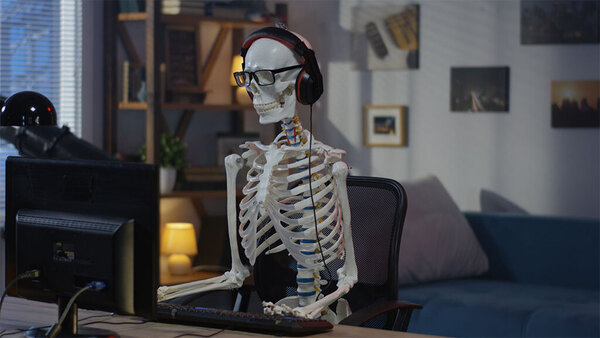Advice
Frightful and common injuries caused by office furniture
Wednesday, October 19, 2022

Just how common are injuries in an office?
According to the HSE, over a million workers are injured or made ill by their work in Great Britain every year. Whilst not all of these injuries can be attributed to poor office furniture, at least some of these injuries can be. Each year, HSE looks at the data recorded from work injuries, loss of lives, days lost through sickness and financial costs to the government and employers. They then make estimates based on yearly figures.
HSE estimates that between 2017/2018 and 2019/2020, an average of 610,000 workers were injured in various workplace accidents. 559,000 workers reported new cases of ill-health that they believe were caused or made worse by their workplace. The total cost of workplace injury and ill health between 2018/2019 was £16.2 billion.
Office injuries caused by inept office furniture
Now we know just how office injuries and time off can affect employers and businesses, let's take a look at some of the most common office injuries and how simple it could be to avoid them!
Repetitive strain injury - Pain from RSI can often be found in the wrists of workers who are repeating movements multiple times throughout the day. Working on a computer for long periods of time is a common cause of RSI. Employers should ensure that office furniture fits the employee correctly, tools and equipment are offered (such as armrests and wrist supports), and a correct posture is adopted.
Back pain - Do your staff often complain of back or neck aches? Have you been meaning to get those chairs replaced for a while? Do your desks readjust depending on who is sitting at them? Back pain is one of the most common reasons for lost days at work and can be quite easily avoided by ensuring your staff have the proper furniture to work at. Bad posture and sitting for long periods will always contribute to back pain.
Eye strain - Focusing on something at the same distance for long periods of time can cause your eyes to become tired and uncomfortable. Whilst there is no link between eye strain and deteriorating eyesight, working on a computer for 8-10 hours a day 5 days a week can cause blurred vision, headaches and an inability to focus. The eye prefers to look at objects that are more than 6 metres away - something that would be impossible for computer work! Regular breaks and ensuring your computer is set ergonomically are imperative.
Slips and falls - Whilst not all slips and falls can be attributed to the office furniture you have, often older and bulkier desks with wide legs or chairs with legs that stick out further can be a cause of falls. Avoid putting your staff in any danger by choosing sleek and ergonomically designed furniture that doesn't take up too much space and is safe for your staff.
Choosing ergonomic office furniture to avoid injuries
An ergonomic workplace is one where employees are able to perform their jobs without undue stress and discomfort. This includes proper lighting, furniture and equipment, and good work habits. Unfortunately, many workplaces fail to meet these requirements.
Many people don’t realise that a poorly designed workstation and/or poor work habits can result in significant health issues. Common symptoms associated with poor workstation design and/or poor work practices include discomfort in the back and neck, hands and wrists, and headaches and eyestrain, among others. These symptoms often occur because the body is forced into unnatural positions due to improper design and/or bad habits.
Ergonomic office furniture choices
Office chairs - purchase office chairs that offer a supportive and adjustable height and back. Chairs should be able to raise themselves high enough, so your employees are able to put their feet flat on the floor whilst having their entire back supported. Office chairs should also come with supportive armrests.
Standing desks - growing in popularity across offices are standing desks. Working from a standing desk is thought to lower blood pressure, improve feelings of mood and fatigue, reduce the likelihood of weight gain and diabetes and reduce back pain.
Readjustable desks - much like standing desks, readjustable desks allow your employees the opportunity to move their desks up and down, depending on whether they would like to sit or stand. Readjustable desks also work for those who are exceptionally tall and require more room under the desk for legs.
Simple changes to office equipment can work miracles, making work more comfortable, convenient and enjoyable. For example, purchasing a standing desk and taking up yoga might seem like overkill, but it could actually save you money in the long run. By reducing strain on your muscles and joints, you'll reduce the likelihood of injury and improve your quality of life. You'll spend less time sick, too – which makes everyone happy!
This may also interest you:
Create the ultimate tranquil office with our feng shui tips
Pre-owned office furniture could combat rising living costs
Frequently Asked Questions | Secondhand Business Furniture
Purchase your office furniture with Recycled Business Furniture
If you are looking to replace your office furniture and reduce the sickness in your office, you may not want to spend tens of thousands of pounds to get brand new furniture for everyone. Luckily, Recycled Business Furniture has curated a fabulous array of secondhand office furniture perfect for savvy businesses that are looking to upgrade their furniture without breaking the bank.
Reduce the sickness in your office next year and purchase office furniture for your staff that will increase their productivity and keep them healthy during working hours. Pay a visit to Recycled Business Furniture today and take a look around our vast showroom.